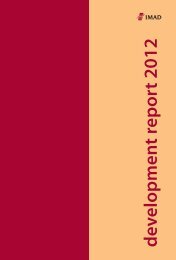Gonzalo C. Caprirolo and Marko Glažar Fiscal multipliers ... - UMAR
Gonzalo C. Caprirolo and Marko Glažar Fiscal multipliers ... - UMAR
Gonzalo C. Caprirolo and Marko Glažar Fiscal multipliers ... - UMAR
Create successful ePaper yourself
Turn your PDF publications into a flip-book with our unique Google optimized e-Paper software.
Working Paper 2/2013<br />
<strong>Fiscal</strong> <strong>multipliers</strong> <strong>and</strong> policy mix during fiscal consolidation process: minimizing the impact<br />
of fiscal adjustment on economic activity (GDP)<br />
3<br />
Figure 1: Impact of 1 p.p. increase in cost of<br />
capital on level of GDP, temporary (IK) <strong>and</strong><br />
permanent increase (IK-p)<br />
Figure 2: Impact of 1 p.p. increase in cost of<br />
capital on GDP growth %, temporary (IK) <strong>and</strong><br />
permanent increase (IK-p)<br />
0,0<br />
-0,2<br />
-0,4<br />
-0,6<br />
-0,8<br />
-1,0<br />
2012 2013 2014 2015 2016 2017 2018 2019 2020<br />
IK<br />
IK_p<br />
0,2<br />
0,0<br />
-0,2<br />
-0,4<br />
-0,6<br />
2012 2013 2014 2015 2016 2017 2018 2019 2020<br />
IK<br />
IK_p<br />
-1,2<br />
-1,4<br />
-0,8<br />
-1,6<br />
-1,0<br />
Source: Own calculations<br />
Source: Own calculations<br />
8. The next step consists of estimating fiscal <strong>multipliers</strong>. Table 1 reports the estimates of the first<br />
year <strong>multipliers</strong> of temporary measures of fiscal consolidation (i.e. ex-ante reduction in<br />
government spending <strong>and</strong> increase in VAT revenue due to VAT rate increase (1 % of GDP)). It<br />
indicates that government spending <strong>multipliers</strong> (i.e. consumption, transfers <strong>and</strong> investment) are<br />
larger than that of indirect taxes (VAT). It also suggests that the size of the multiplier of<br />
government consumption is not very different from that of investment.<br />
Table 1: First-year <strong>multipliers</strong> from 1 % of GDP temporary measure<br />
Government spending<br />
Consumption Transfers Investment VAT<br />
-0.44 -0.36 -0.50 -0.29<br />
Source: Own calculations<br />
9. Since the fiscal intervention (i.e. shock) is conceived temporary, then in the second year it is<br />
reversed in the same magnitude as in the first year with positive effect on GDP. Figure 3 shows<br />
the resulting dynamics on the level of GDP. After the two shocks (negative <strong>and</strong> positive) GDP<br />
recovers in all cases but the speed of recovery is very slow in the case of investment (I). GDP<br />
level recovers faster in the case of change in transfers (TR), followed by changes in VAT rate <strong>and</strong><br />
government consumption (G). After three years fallowing the temporary shocks (2015) the<br />
adverse effect of government consumption on economic activity is close to that of VAT which is<br />
consistent with empirical findings regarding the relative VAT’s lower cost in terms of GDP in the<br />
short-term (IMF 2012).

















